Stories from the Field
Worldwide
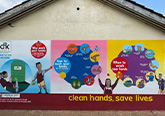
CDC and partners assessed WASH conditions and implemented WASH projects in select healthcare facilities, community settings, and households that were considered higher risk for COVID-19 transmission.

In the world today, close to 1 billion people still drink water collected directly from streams, lakes and shallow hand-dug wells, while hundreds of millions more drink contaminated water from unsafe municipal systems or borehole wells.

In global health work, it is important to find legacies that stand the test of time and scrutiny. CDC and USAID’s collaboration to address critical global health issues is one that provides both agencies the opportunity to build such a legacy.

It still makes Fatoma Dia’s eyes widen whenever the Hilton hotel cleaning worker sees a bar of barely used soap on a bathroom counter. “This,” she says, picking it up with a gloved hand and dropping it in a brown bucket, “is valuable where I come from.” The 35-year-old grew up in a mountainous region of southern Sudan where soap can cost more than a day’s wages. CNN Heroes reports on the CDC-WHO collaboration that has led to facilitating better sanitation in needy regions and teaching people the importance of basic hand washing.
Africa
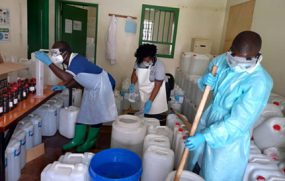
As a result of CDC and partner preparedness efforts, Ugandan hospitals and healthcare workers received quick and sufficient supply of alcohol-based hand rub during the ongoing Ebola outbreak.

As COVID-19 spread around the world in early 2020, countries – rich and poor – quickly faced a global shortage of hand sanitizer, one of the protective products that contribute to stopping the spread of the disease. However, some healthcare facilities (HCFs) in Uganda did not have to scramble to find hand sanitizer. With support from CDC, a local partner—the Infectious Diseases Institute (IDI)—was already helping these facilities produce their own low-cost alcohol-based hand rub (ABHR) and providing communications materials to promote good hand hygiene practices.
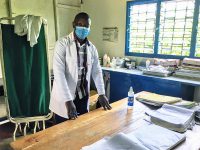
Hand hygiene is a simple and effective way to help prevent the spread of infections, such as COVID-19. However, people in low-resource settings often do not have access to hand hygiene supplies, such as soap, water, and alcohol-based hand rub. This is a serious problem in healthcare facilities, where both healthcare workers and patients risk infections if hand hygiene supplies are not available. To increase access to hand hygiene supplies in underserved healthcare facilities in Western Kenya, CDC is supporting the production and distribution of alcohol-based hand rub by Safe Water and AIDS Project (SWAP).

Public health officials, partners, and stakeholders in Sierra Leone asked CDC to help strengthen the country’s WASH workforce to combat diseases such as cholera, dysentery, hepatitis A, typhoid, and polio and to be better prepared for future disasters and outbreaks.

Working with global partners, CDC supported Cameroon’s government in launching its largest-ever oral cholera vaccination campaign, targeting 127,000 people in regions most at risk for the disease. Cholera prevention activities are part of the Global Health Security Agenda’s Emergency Management project in Cameroon.

Have you ever stopped to think about how many times you use a toilet each day? We often take it for granted that when we “need to go,” a toilet will be nearby. However, throughout the world, an estimated 2.5 billion people lack basic sanitation—which means they do not have access to toilets or safe latrines, or to services such as garbage collection and wastewater treatment and disposal. Without toilets or latrines, people who “need to go” have no other option than to relieve themselves on open land or in bodies of water. This can lead to contamination of a community’s drinking water source, making the water unsafe to drink.

PATH’s Safe Water Project recently launched its first pilot activity in Kenya to explore the potential for offering a ceramic water purifier (CWP) in a sales model designed for fast-moving consumer goods (FMCGs). The basket-of-goods (BOG) model is a promising business model found in several African countries. The Safe Water and AIDS Project (SWAP) in Kenya uses the model to ensure that households in remote areas have access to low-cost, high-impact health products such as sanitary pads, soap, condoms, and water treatment solutions.

About 200,000 people live in Kibera, a slum on the outskirts of Nairobi, Kenya, and the largest informal settlement in East Africa. With an estimated one-pit latrine for every 200 people, residents use plastic bags for relief and then dispose of them anywhere. This practice, known as ‘flying toilets’, is more common at night among women and children concerned about the area’s lack of security. Without sanitation facilities to contain and dispose of human feces, those living nearby are at risk for enteric diseases (those that cause diarrhea, nausea, or vomiting), such as typhoid fever.

“What if we lost 50 city buses full of children today?” asks Michael Beach, the associate director for healthy water in CDC’s National Center for Emerging and Zoonotic Infectious Diseases. “That’s 2,195 children—the number who die daily of diarrhea around the world. That’s more than die from AIDS, malaria, and measles combined.”

Over 1.1 billion people worldwide do not have access to safe drinking water. Nearly two million children die each year due to diarrhea and other infectious diseases resulting from unsafe drinking water, inadequate sanitation, and poor hygiene. To prevent these deaths, CDC and its partners developed the Safe Water System.

Over 1.1 billion people worldwide do not have access to safe drinking water. Nearly two million children die each year due to diarrhea and other infectious diseases resulting from unsafe drinking water, inadequate sanitation, and poor hygiene. To prevent these deaths, CDC and its partners developed the Safe Water System.
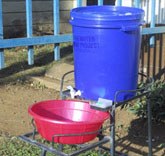
Limited access to safe water in Nyanza and Western Provinces, Kenya is a major problem. Diarrhea rates in these regions are among the highest in Kenya. An inexpensive safe water system can reduce the risk of diarrhea from 25–85%.
Haiti
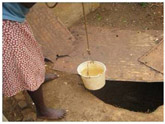
When the January 2010 earthquake struck Haiti, the first priorities of Haitian public health officials and their partners, including CDC and USAID, were improving access to clean water and sanitation and promoting basic hygiene to protect Haitians from threats they faced living in crowded, temporary camps.

When a cholera outbreak occurs in resource-limited countries like Haiti, where sanitary conditions are poor and safe water systems do not exist, public health officials must act quickly. A first request of CDC and partners was to help educate health care workers to manage cholera and teach Haitians how to prevent it.